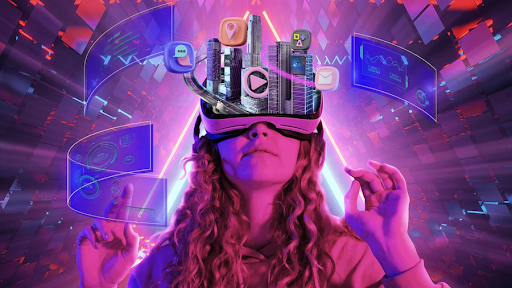Let's Discuss
Enquire NowWould you rather live in reality or virtual reality?
The world is migrating to a place beyond our imagination, or perhaps to our imagination itself. With Metaverse being the next big thing, people are beginning to acquire and invest in virtual lands in order to create their own virtual settings that will soon become their new reality. This transition is extremely beneficial for companies to expand their enterprise and venture into the virtual landscape. However, here arises a question of where to claim your virtual space. The answer is either Decentraland or The Sandbox, which are the two most popular Metaverse platforms at the moment.
So which one is better? To answer that, let us see their differences.

Decentraland is a virtual world that aims to mimic our reality by allowing users to socialize, work, and play in a virtual setting. Sandbox is more of a user-generated and user-owned gaming ecosystem. They are decentralized systems based on the Ethereum blockchain that provide users with complete autonomy (Decentralized Autonomous Organizations – DAO). Users have a say in the ideas that are adopted, the smart contracts that are implemented, and the overall administration of these platforms, which makes it desirable. However, the amount of area available for users to create their own in-world items such as avatars, games, products, buildings, and other items is limited in these virtual worlds. Decentraland and The Sandbox both offer native tokens that may be used to monetize items, land, and assets in the real world.
The Virtual Platform
- Decentraland is the leading crypto project and the greatest platform in the Metaverse. It is one of the first metaverse platforms, constructed as a two-dimensional business, which later evolved to a completely immersive 3D metaverse. At present, it hosts over 600M active monthly users. According to CoinDesk, a play-to-earn poker game on the platform has roughly 6,000 unique players per day, producing more than $7.5 million in revenue.
- Sandbox, on the other hand, is the second-biggest crypto Metaverse project by market cap, and the largest gaming-centric Metaverse project. It is a collection of user-generated games and content where users can design their own games and in-game assets. Sandbox is clearly more game-focused than Decentraland, with discrete, segregated environments, housing user-created gaming experiences. Among the gaming tools available are a 3D Voxel modeling toolset and a marketplace for gamers to buy and trade game items.
The Virtual Land
- Decentraland has 90,601 plots of virtual space that contain individual parcels, estates (multiple parcels), districts (parcels with similar themes), and plazas which are owned by communities and therefore cannot be traded. The smallest piece of land that can be owned by an individual is known as a parcel. Decentraland’s virtual land is solely available on its own decentral and marketplace. The scarcity of this space results in an increase in its value.
- Sandbox, on the other hand, has 166,464 plots that can be divided into Estates which may be owned by a single person or Districts which can be owned by multiple people. Sandbox’s virtual land is available on both the Sandbox and OpenSea (the largest NFT marketplace) marketplaces.
The Virtual Tokens
- Decentraland has two main native tokens: MANA and LAND.
MANA is an ERC-20 token that is used to buy virtual goods on the Decentraland Marketplace. The virtual land within the Decentraland world is represented by the NFT LAND. Users can spend MANA to obtain LAND tokens, as well as upgrade and purchase avatars, names, products, and services. A user who owns LAND has complete control over the programs and structures they construct on it.
There are also WEARS which are various pieces of clothing, accessories, and body features that can be used to create a Decentraland avatar.
- Sandbox employs three main tokens: SAND, LAND, and ASSETS.
SAND is the ERC-20 token that facilitates all transactions and interactions inside the Sandbox ecosystem. LAND is a digital piece of land that players purchase in order to fill with interactive experiences, games, and assets. On the public Ethereum blockchain, each LAND is a one-of-a-kind non-fungible token (ERC-721). ASSETS are created by players that assemble user-generated content. They are based on the ERC-1155 standard and can be exchanged on the market. They are a hybrid of crypto and NFT whose primary purpose is to be used as building blocks in The Sandbox Game Maker.
The Market Value
The Sandbox’s tokens are currently valued at $3.3 billion, whereas Decentraland’s market cap is $4.5 billion. The total supply of Decentraland tokens is 2,193,785,227 MANA and of The Sandbox is 3,000,000,000 SAND.
The Virtual Aesthetics
Both platforms are generally attractive, albeit Sandbox has slightly better aesthetics than Decentraland. The appeal of both platforms stems mostly from the technology behind them as well as the fact that they are decentralized.
Returning to our original question; which Metaverse platform is better? Though some may argue that The Sandbox leads this debate, to be honest, it’s just a matter of preferences. As the two Metaverse giants continue to grow and expand, it is safe to say that their goals are likely to become increasingly similar. If you are a business looking to launch a project in the Metaverse, you’ll need the assistance of a team that is competent enough to understand the concepts centered around it. A company like Dexlock, which specializes in Blockchain, Web 3.0 cryptocurrency, virtual reality, and other related technologies, can assist you in becoming a master player in the Metaverse world. Connect with us here.
Disclaimer: The opinions expressed in this article are those of the author(s) and do not necessarily reflect the positions of Dexlock.



